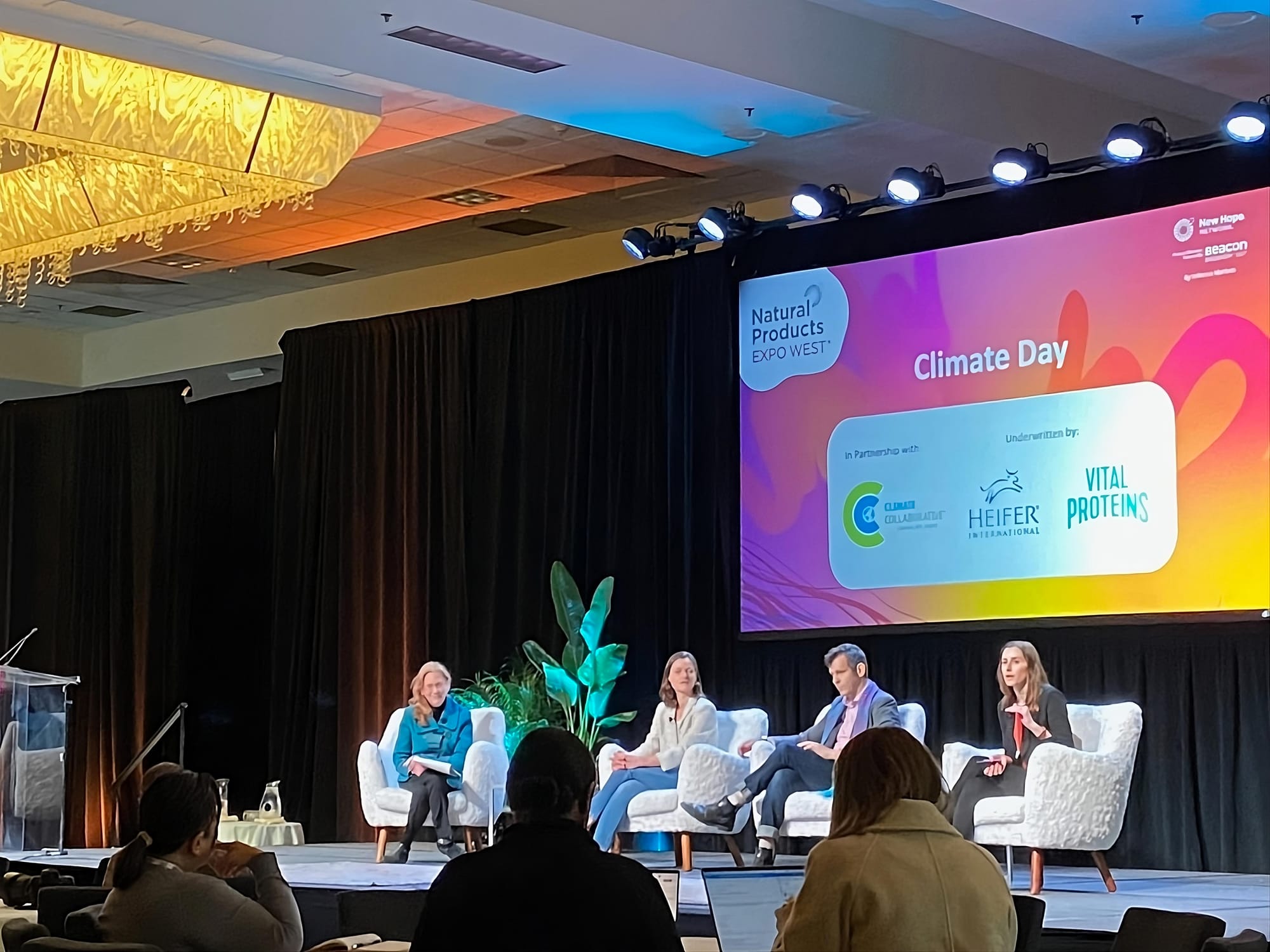CPG Brands Should Lead With Consumer Benefits, Not Solely Sustainability — Insights From Expo West Panelists
To close the gap between consumers wanting and buying from sustainable brands, consider emphasizing how sustainability addresses core needs.

With more consumers caring about sustainability and wanting to see brands make a positive impact, you might think it makes sense to put climate claims front and center on consumer packaged goods. However, many brands have noticed an apparent disconnect between what consumers say and what consumers do.
BCG research found that while 77% of global survey respondents said they were concerned about sustainability within the fresh and packaged food category, only 20% are taking the action of buying sustainable products.
Yet the issue isn’t necessarily that consumers are all talk. Instead, CPG brands might be missing the mark on how to reach consumers with sustainability messaging. Rather than making climate the focal point of your marketing, consider emphasizing consumer benefits first, with sustainability driving these benefits and providing an added bonus.
At the Expo West 2024 Climate Day, panelists shared the importance of highlighting how products benefit individuals, rather than leading with climate-oriented language and benefits.
Many consumers aren’t connecting with current sustainability marketing efforts because the messaging is presented as overly altruistic, explained Sophie Egan, director of strategy at Food for Climate League.
Talking about going zero-waste because the planet is counting on you might speak to a small segment of the population seeking products that help them fulfill a higher purpose, she said, but most people are focused on more fundamental needs, like just getting through the day-to-day challenge of feeding their families while staying on budget.
Think of Maslow’s hierarchy of needs and how many food brands aim right for the top of the pyramid with aspirational climate-oriented messaging, rather than focusing on more foundational needs.
“We think [consumers] actually do care about climate, they just don't care as much as they care about other core needs. And so the more that you can connect climate-smart food choices to these other core needs, the greater chance you have of reaching a greater swath of the population,” said Egan.
For example, instead of trying to convince consumers to buy a product because it’s vegan, which can have associated climate benefits, consider specifying how a product’s use of plant-based ingredients might mean that it has lower cholesterol than a previous formulation. Or maybe using regenerative organic ingredients creates more flavor, as some claim.
Food consumers prioritize taste, cost, and convenience above sustainability, said Charlotte Vallaeys, natural and organic associate expert at General Mills. “They're also going to prioritize good-for-me benefits over the good-for-us or better-for-the-planet benefits.”
“That’s not to say that people don't care. Most consumers do care. Environmental messaging and on-pack claims will be a tiebreaker, but they're not going to be the main driver,” she added.
Prioritizing Good-for-You Benefits
In order to get the brand perception and consumer trust lifts that can come from sustainability, while also making a more direct impact on product sales, CPG brands should consider climate initiatives that pose more immediate benefits to consumers. That way, you can still make credible climate claims while growing sales.
Take Annie’s, a General Mills brand famous for its mac & cheese products.
The brand launched two limited edition versions of mac & cheese that had very prominent environmental messaging, based around supporting regenerative farming, explained Vallaeys. However, those products have been discontinued and essentially been replaced by SUPER! Mac, which accomplishes similar climate goals yet focuses on the consumer benefit of getting more protein.
Specifically, this new line of mac & cheese boosts protein levels — a key concern for consumers, said Vallaeys — through pea protein.
While Annie’s could have increased the dairy content to add protein and provide this consumer benefit, Annie’s found an opportunity to do so in alignment with its sustainability goals. By using pea protein, Annie’s has been able to provide a larger market for organic farmers who want to grow yellow field peas as a rotational crop between wheat plantings.
Planting these peas provides benefits such as drawing nitrogen down into the soil, so farmers then don’t have to apply any external nitrogen fertilizer when planting wheat, explained Vallaeys.
Nitrogen fertilizer production and usage accounts for around 5% of global greenhouse gas emissions, according to Nature. So, with the use of rotational crops like peas, farmers gain benefits like another revenue stream, while providing the planetary benefit of reducing the need for fertilizer. Even organic fertilizer can increase carbon emissions, so the less that needs to be added, the better.
“We also know that plant-based protein is one of the more impactful choices that people can take to have more sustainable diets,” said Vallaeys.
Changing Defaults
As Annie’s SUPER! Mac line shows, it’s possible to incorporate climate-friendly initiatives in subtle ways while providing more benefits to consumers. The brand did not put any sustainability messaging on SUPER! Mac packaging, yet selling this product still helps General Mills reach larger corporate sustainability goals, while consumers get the benefit of a higher-protein product.
“We made the default choice the climate-friendlier option,” said Vallaeys.
Changing defaults is also something that General Mills is working on through the incorporation of the Kernza grain into more products. Through its Cascadian Farm brand, the company launched a Kernza-focused cereal, but now General Mills is taking more of a “little in a lot” approach, said Vallaeys.
“Rather than launch more of these SKUs that have very prominent environmental messaging, we're thinking about how we can get a little bit of Kernza…into our top-selling SKUs. So meeting consumers where they're at, what they are already buying, that would have a huge impact,” she explained.
In other words, consumers don’t have to make any apparent sacrifices and can instead have more sustainable products by default. While it might be ideal to replace an even higher percentage of traditional wheat with climate-friendly grains like Kernza, that would take a more concerted effort to change consumer behavior and might not be as effective, especially in terms of sparking initial change.
For farmers, “if there's no market for Kernza, then this climate-friendly crop that really impacts the climate resilience of their farms, they're just not going to grow it. So if we're thinking in that way about how can we, General Mills, support farmers when they grow these crops, we think that ‘little in a lot’ approach is a very effective approach,” said Vallaeys.
Changing defaults to more climate-friendly options is also something that the Food for Climate League has worked on. As Egan explained, nudges like automatic enrollment in areas like organ donation and 401(k) plans have been effective at increasing participation, and the same can happen within the food world.
In working with Sodexo and the Better Food Foundation, they ran a trial in university dining halls where they tested making the default option a plant-based meal, while still having a meat-based meal available for those who asked.
This trial increased selection of the plant-based option by 58%, explained Egan, and it has been so successful that Sodexo has rolled it out to over 400 campus locations to help the company meet its plant-based meal goals. That’s key because a Sodexo analysis found that 70% of the company’s U.S. supply carbon footprint came from animal-based food purchases.

In the CPG world, companies can similarly nudge consumers toward more sustainable behaviors by incorporating more climate-friendly ingredients by default, for example, or using more sustainable packaging. At Expo West, many brands provided samples without any cutlery or serving dishes, thereby cutting down on waste by default.
Ultimately, “you don't have to speak about the climate crisis or speak about how sustainable a product is in order to stoke climate-beneficial behaviors,” said Egan.
Disclosure: Carbon Neutral Copy's parent company, JournoContent LLC, has clients involved in sustainability-related areas, among others. The owner of Carbon Neutral Copy, Jacob (Jake) Safane, has investments in sustainability-related companies, among others.
As such, conflicts of interest related to these and other investments/business relationships, even if unintended, may exist at times. Please email info@carbonneutralcopy.com if you'd like further clarification on any issues.
